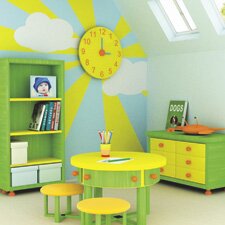 |
|
Have fun painting your kids’ rooms by incorporating them in the process, as well as by using paints free from volatile organic compounds and other toxins, like those from Mythic.
photo: Mythic Paint
|
Kidding around
Rest easy knowing your children’s rooms are safe yet fun
by Dawn Hintgen
Not much changes faster than the tastes of growing children. One day, they might want everything they own in ballerina pink and gold; the next, they’ve discovered rainforest frogs so it’s all about bold greens and bright reds.
A child’s room naturally goes through three to four major changes in function as he or she grows from the nursery stage through adolescence. Any parent who has been through these second and third stages knows that a child will change favorite colors and styles much more often than this.
To keep up with these changes while avoiding breaking the bank, design your child’s room from the beginning with the future in mind. By shopping smart for large, long-lasting items and using accessories to switch up styles, you can naturally incorporate sustainable design principals into the process while saving plenty of money and materials down the road.
Solid footing
Before a bedroom is filled with furniture and accessories, it’s simply a box of floor and walls. Framing this box with high-quality, healthy elements will start your design off right. The floor is something that’s not as easily changed as the wall color, so reduce the need to replace it down the road by selecting flooring in a neutral finish that can adapt to your children’s changing tastes.
Formaldehyde-free hardwoods, bamboo, cork, and natural linoleum come in neutral color options and make it easy to keep the air clean for those prone to allergies and sensitivities. They’re also easier to clean than wall-to-wall carpeting and do not trap dust or pet dander. If a softer play area is desired, then incorporate easy-to clean rugs or carpet tiles like those from FLOR.
Rainbow walls
Wall color likely will be one of the things that changes each time a room makeover comes around, making paint one of the most important considerations when planning a child’s room.
Unfortunately, up to 50 percent of the toxins found in standard paint can remain in the room for as long as six years after it’s applied. Choosing a paint free from volatile organic compounds (VOCs) that’s also nontoxic is one of the best decisions you can make for your child’s room, considering the amount of time they spend in there.
Some zero-VOC paints still contain chemicals such as formaldehyde, crystalline silica and other known toxic materials, so shop carefully. Once a healthy paint brand has been selected, don’t limit color or creativity; wall color is easy to change, and your kids can get involved in the process.
Special stuff
Furniture and accessories make a room a special space for kids. While accessories can be altered to the changing needs and styles of growing children with little waste or expense, large items like beds, dressers, and shelving are best chosen with a long life in mind.
When choosing a bed, consider that the little person looking up at you right now might be looking down at you before he or she graduates from high school. Something sturdy with a neutral-style frame can last throughout childhood and beyond. A neutral frame also allows bedding, which is relatively inexpensive, to be changed with evolving tastes.
Storage options fall into this category as well. Look for sturdy, solid wood units in a natural finish or something that can be repainted easily. For a toddler, shelving can be filled with brightly colored bins. As a child grows, these bins can be switched out to adjust to different tastes, or they can be taken out completely to make room for books, stacks of board games, or collections.
Solid wood does not have the toxic glues that particle-board furniture can have. A child’s immune system is less developed than an adult’s, so children are more susceptible to the health issues that come from compromised indoor air quality. This is why an investment in solid wood furniture is more than worth it.
Dawn Hintgen is co-owner of Common Ground Green Building Center in downtown Durham. To learn more, call (919) 688-1500 or visit www.commongroundgreen.com.